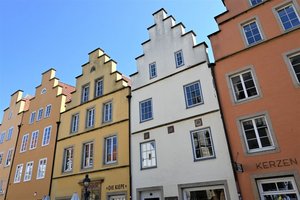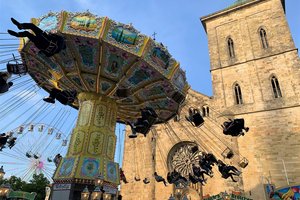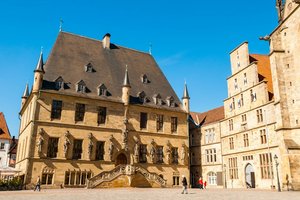Usually referred to as Heger Tor Gate, the structure has officially borne the name Waterloo Tor Gate since it was built in 1817. The Osnabrück citizen Georg Friedrich von Gülich donated 1,000 thalers (a former Austrian, Swiss or German silver coin) for the erection of a memorial in honour of the Osnabrück soldiers who fought in the Battle of Waterloo in 1815. These had taken part in the King's German Legion under British high command in the decisive battle against the French Emperor Napoleon. Prior to its annexation by Napoleon, Osnabrück had been part of Hanover since 1803 and as such was connected to the British Crown. The path inspector Johann Christian Siekmann designed and erected the Waterloo Gate, which, as a neo-classical triumphal arch, was inspired by the Arch of Titus in Rome and at the same time took up the defensive character of the original fortifications demolished in 1815. Siekmann fitted the gate into the remains of the former fortification.
The archway is framed by Ionic columns standing on a plinth and stylobate. The dedication of the donor is enthroned in golden lettering in the centre above the arch:
"G.F.v.GÜLICH D.R.D. DEDICATES THIS MEMORIALl
TO THE OSNABRÜCK WARRIORS WHO DIED AT WATERLOO
18 JUNE 1815 PROVING GERMAN COURAGE”
(D.R.D. = Der Rechte Doktor, meaning Gülich was a Doctor of Law).
The platform of the gate can be reached via the ramps and a stairway built on the side. From there you have a view of Osnabrück's medieval Altstadt, the old town, that is well worth seeing. The Waterloo Gate itself forms the entrance to the old town.
The historic Heger Tor Gate
Before it was demolished, the original Heger Tor Gate was about twenty metres further west of the Waterloo Gate. This can be seen from the fact that the customs house called Akzisehaus, part of the Museums Quarter, is now on the opposite side of the wall. It used to be right next to the original city gate. The medieval Heger Tor formed a defensive structure consisting of several buildings with an 18-metre-high tower, a gate, a bastion and a Zwinger, an outer ward which represents an open kill zone area between two defensive walls that is used for defensive purposes. People who wanted to enter the town first crossed an arched bridge in front of it, which led over an artificial river, the town moat. The river or moat was constructed in such a way that a kind of island was created between its two watercourses. On this island were the customs houses, Akzisehäuser, where weapons and other goods were searched for that had to be taxed or were not allowed to be imported. A drawbridge and a gatehouse behind it finally led to the city centre.
Today, the name "Heger Tor Gate" has become established in the vernacular as the name for the "Waterloo Tor Gate".
The Heger Tor Gate Quarter
From the Waterloo Tor Gate you look out over the historic Heger Tor Gate quarter. Covering an area of around 5.5 hectares, the quarter is known for its rich gastronomy and pub scene, exclusive boutiques and Steinwerke (stonework buildings). It forms the outermost western part of Osnabrück's old town (Altstadt). Until the 12th century, this quarter was outside the city walls. However, more and more people settled outside the city gates and eventually this area was included in the city fortifications. The historic city wall and the boundary of the quarter ran along the Bocksmauer and Rolandsmauer streets (Mauer meaning wall in German). During the Second World War, the quarter was almost completely destroyed by air raids, but was reconstructed during the post-war period. Prominent buildings in the quarter are, for example, the Steinwerk buildings in Bierstraße (Beer Street), Willmann House, Hotel Walhalla and Haus Tenge (house of the family Tenge) in Krahnstraße (Crane Street).






